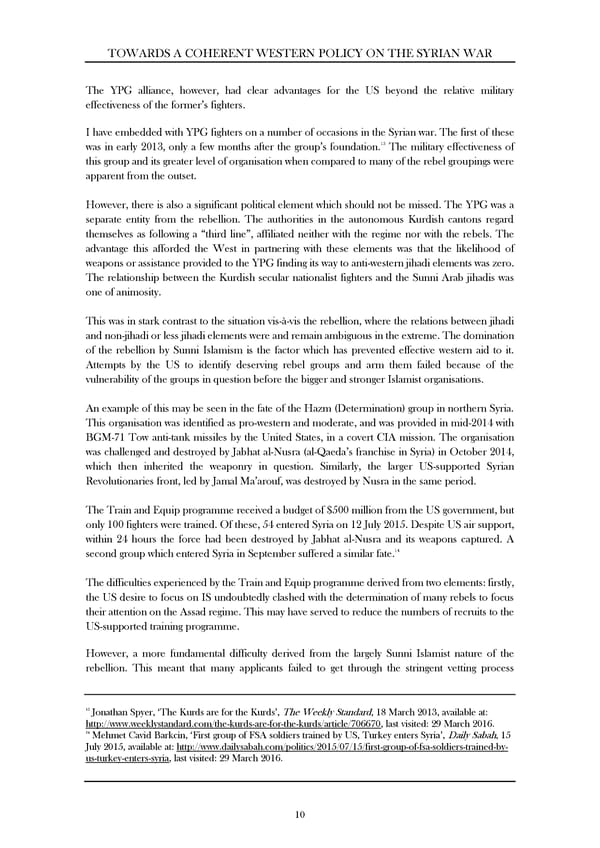TOWARDS A COHERENT WESTERN POLICY ON THE SYRIAN WAR The YPG alliance, however, had clear advantages for the US beyond the relative military effectiveness of the former’s fighters. I have embedded with YPG fighters on a number of occasions in the Syrian war. The first of these 13 was in early 2013, only a few months after the group’s foundation. The military effectiveness of this group and its greater level of organisation when compared to many of the rebel groupings were apparent from the outset. However, there is also a significant political element which should not be missed. The YPG was a separate entity from the rebellion. The authorities in the autonomous Kurdish cantons regard themselves as following a “third line”, affiliated neither with the regime nor with the rebels. The advantage this afforded the West in partnering with these elements was that the likelihood of weapons or assistance provided to the YPG finding its way to anti-western jihadi elements was zero. The relationship between the Kurdish secular nationalist fighters and the Sunni Arab jihadis was one of animosity. This was in stark contrast to the situation vis-à-vis the rebellion, where the relations between jihadi and non-jihadi or less jihadi elements were and remain ambiguous in the extreme. The domination of the rebellion by Sunni Islamism is the factor which has prevented effective western aid to it. Attempts by the US to identify deserving rebel groups and arm them failed because of the vulnerability of the groups in question before the bigger and stronger Islamist organisations. An example of this may be seen in the fate of the Hazm (Determination) group in northern Syria. This organisation was identified as pro-western and moderate, and was provided in mid-2014 with BGM-71 Tow anti-tank missiles by the United States, in a covert CIA mission. The organisation was challenged and destroyed by Jabhat al-Nusra (al-Qaeda’s franchise in Syria) in October 2014, which then inherited the weaponry in question. Similarly, the larger US-supported Syrian Revolutionaries front, led by Jamal Ma’arouf, was destroyed by Nusra in the same period. The Train and Equip programme received a budget of $500 million from the US government, but only 100 fighters were trained. Of these, 54 entered Syria on 12 July 2015. Despite US air support, within 24 hours the force had been destroyed by Jabhat al-Nusra and its weapons captured. A 14 second group which entered Syria in September suffered a similar fate. The difficulties experienced by the Train and Equip programme derived from two elements: firstly, the US desire to focus on IS undoubtedly clashed with the determination of many rebels to focus their attention on the Assad regime. This may have served to reduce the numbers of recruits to the US-supported training programme. However, a more fundamental difficulty derived from the largely Sunni Islamist nature of the rebellion. This meant that many applicants failed to get through the stringent vetting process 13 Jonathan Spyer, ‘The Kurds are for the Kurds’, The Weekly Standard, 18 March 2013, available at: http://www.weeklystandard.com/the-kurds-are-for-the-kurds/article/706670, last visited: 29 March 2016. 14 Mehmet Cavid Barkcin, ‘First group of FSA soldiers trained by US, Turkey enters Syria’, Daily Sabah, 15 July 2015, available at: http://www.dailysabah.com/politics/2015/07/15/first-group-of-fsa-soldiers-trained-by- us-turkey-enters-syria, last visited: 29 March 2016. 10
 Towards A Coherent Policy On The Syrian War Page 11 Page 13
Towards A Coherent Policy On The Syrian War Page 11 Page 13